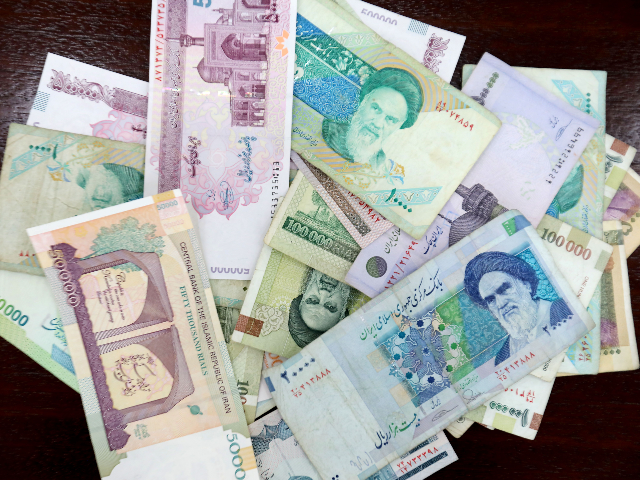Iran’s Central Bank announced Wednesday that the nation would rename the national currency, the rial, as the “toman” and “delete four zeros” from its value.
The move follows months of intense American sanctions on Iran’s oil industry and mimics a similar move to bolster the bolívar currency in Venezuela.
“The council of ministers, at a meeting presided by President Hassan Rouhani this morning, approved the central bank’s proposed bill to change the national currency from the rial to the toman and delete four zeros,” the Iranian Islamic regime said in a media statement, according to the government news outlet PressTV. As the reevaluation of the currency must pass through the dictatorship’s rubber-stamp legislature, it will not be confirmed until a final vote in the Iranian parliament.
PressTV admitted the plan to remove the zeros, an attempt to strengthen the currency’s value, “found traction after the national currency lost more than 60 percent of its value in 2018,” after the United States withdrew from the international nuclear deal with Tehran. The outlet blamed Washington for sending the rial into a “tailspin” and prices of basic goods in the country “through the roof.”
The administration of President Donald Trump walked out of the nuclear deal, formally the 2015 Joint Comprehensive Plan of Action (JCPOA), after collecting significant evidence that Iran was violating the provisions of the deal and using its windfall from sanctions relief to fund Hezbollah, support Syrian dictator Bashar al-Assad, and spread the influence of Shiite terrorist organizations throughout the Middle East and Latin America.
While the Central Bank of Iran blamed Trump for having to change the value of the rial, changing the currency’s name was reportedly a matter of convenience.
“The reversal to the toman – in use until the 1930s – does away with a duel denomination which many visitors of Iran find confusing. While the rial is the official name, Iranians still make their calculations in toman,” PressTV noted. One toman will still be worth 100 rials, potentially suggesting that the name change is also a way of making the true collapse of the rial’s value less obvious.
Abdolnaser Hemmati, the governor of the Central Bank of Iran, claimed in remarks to Iran’s Mehr news agency that economic instability in the country’s foreign exchange market was an “illusion” created by Iran’s enemies. Mehr claimed that the Iranian economy had already begun to improve even though “nothing is felt at supermarkets, chain stores, bazaars, etc.” Citing a domestic expert, Mehr claimed that the U.S. sanctions currently starving the Iranian elite “can be an opportunity for Iran to reduce its reliance on oil revenues and move towards an … indigenous economy.”
Iran’s oil exports have reportedly fallen by 77 percent currently, compared to the same timeframe last year. Its Gross Domestic Product (GDP) fell 4.9 percent over the fiscal year ending March 21 – significantly more than the World Bank’s prediction of a 1.9-percent drop.
The U.S.-funded Radio Farda reported last week that point-to-point inflation in Iran hit a record high that week at 48 percent, increasing at a slightly slower rate than it had in recent months but nonetheless significantly impacting the average Iranian’s ability to buy basic food and household goods.
“According to estimates made by the Iranian Statistical Center, a quarter of the income of an Iranian family is spent on foodstuff and beverages,” Radio Farda noted. “The increase in the price of food has been higher, nearly twofold, compared with other goods and services.”
In cutting zeros from the value of its national currency, Iran has adopted the policies of close ally Venezuela. Dictator Nicolás Maduro announced in March 2018 that, in response to the collapse of Venezuela’s economy after two decades of socialism, his government would cut three zeros from the value of the bolívar.
“I have decided to remove three zeroes from our currency and take all current currency out of circulation and instead implement a new currency with three fewer zeroes,” Maduro announced. Maduro ultimately removed five zeros, not three, and introduced the confusing “sovereign bolívar,” which triggered chaos at Venezuelan banks, as Maduro had also introduced a cryptocurrency, the “petro” recently to stabilize the economy.
Last month, Venezuela printed a 50,000-bolívar note to help citizens buy products, as their value has become too high to carry the necessary amount of money for purchases in a wallet. It is not clear at press time if the bolívar currently in circulation is the original or the “sovereign” variety.
Iran’s economy appears to be going the way of Venezuela’s after months of sanctions, which Tehran simultaneously claims have not harmed the glorious Islamic revolution while laying blame on them exclusively for the country’s economic woes. The sanctions, American officials have revealed, have damaged Iran’s ability to fund Shiite terrorist activities in the region that it invested heavily in following the signing of the JCPOA.
“Today by nearly every metric the regime and its proxies are weaker than when our pressure began. … Our pressure campaign is working. It is making Iran’s violent and expansionist foreign policy cost prohibitive,” Brian Hook, the State Department’s special representative for Iran, told Congress last month.
“In March, Hezbollah’s leader, Hassan Nasrallah, went on TV and made a public appeal for donations,” Hook noted. “Hezbollah has placed piggy banks in grocery stores and in retail outlets seeking the spare change of people.”

COMMENTS
Please let us know if you're having issues with commenting.